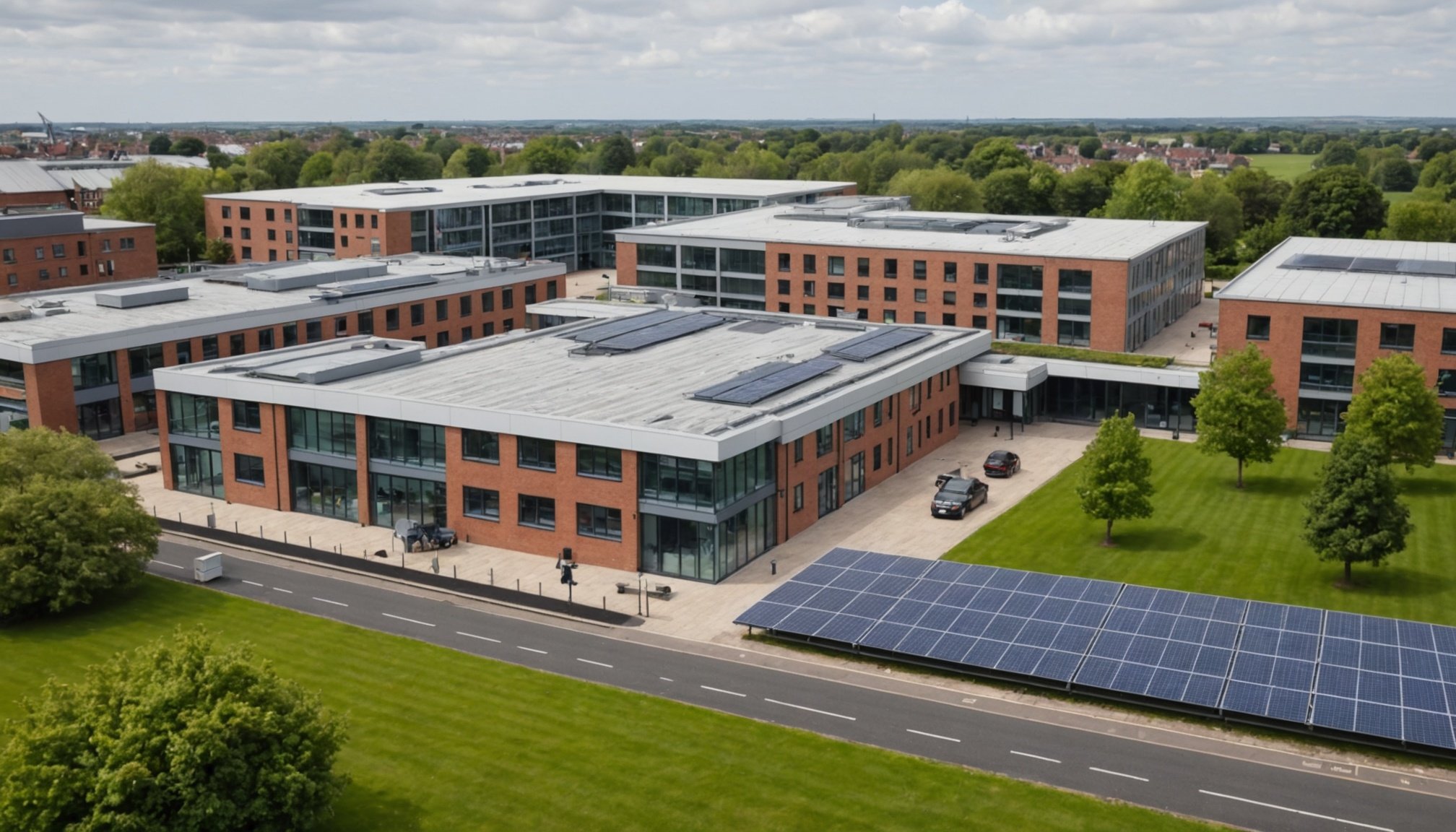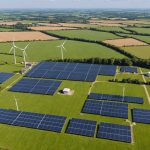Unlocking the Benefits: Fiscal Incentives for Building Energy-Efficient Structures in the UK
The Urgent Need for Energy Efficiency in Buildings
As the UK strives to meet its ambitious climate goals, including cutting carbon emissions by 81% from 1990 levels by 2035, the focus on energy efficiency in buildings has never been more critical. Buildings are responsible for nearly 40% of global energy-related carbon emissions and 50% of all extracted materials, making them a key target for decarbonization efforts[1].
The UK government, along with industry stakeholders, is working tirelessly to develop and implement strategies that encourage the adoption of energy-efficient practices in both domestic and non-domestic buildings. One of the cornerstone initiatives is the expansion of the Minimum Energy Efficiency Standards (MEES), which aims to improve the energy efficiency of privately rented buildings in England and Wales.
In parallel : Essential Strategies for UK Landlords to Navigate Upcoming Eviction Law Changes
Minimum Energy Efficiency Standards (MEES): A Key Driver for Change
Introduced under the Energy Efficiency (Private Rented Property) (England & Wales) Regulations 2015, MEES has been phased in since 2016. The standards are set to become even more stringent, with proposals to raise the minimum standard for commercial buildings to an EPC rating of B by 2030. This includes an intermediate target of an EPC rating of C by 2027 and a requirement for all let buildings to have an EPC at all times, creating a database for easier scrutiny[1].
However, the implementation of these standards faces several challenges, including the need for clear guidelines on EPC targets, timelines, and exemptions. Industry bodies like the British Property Federation have been advocating for urgent action, suggesting targeted financial incentives to aid the cost of retrofitting buildings and encouraging the sharing of energy consumption data between owners and occupiers[1].
Topic to read : Unlocking Investment Opportunities: Tapping into the Rising Demand for Eco-Friendly Buildings in the UK
Fiscal Incentives: A Catalyst for Change
The UK government has introduced a range of fiscal incentives to support the decarbonization of buildings. Here are some of the key measures:
Tax Relief and Exemptions
- The Value Added Tax (Installation of Energy-Saving Materials) Order 2022 provides temporary relief from VAT on energy-saving materials such as insulation, central heating system controls, solar panels, and heat pumps. This relief is in force from 1 April 2022 until 31 March 2027[3].
- Targeted business rates exemptions for eligible plant and machinery used in onsite renewable energy generation and storage, as well as a 100% relief for eligible low-carbon heat networks, are also in place[3].
Grants and Funding
- The Boiler Upgrade Scheme (BUS), introduced in April 2022, provides grants to support the installation of more energy-efficient heating in homes and commercial buildings in England and Wales[5].
- The Energy Company Obligation has been expanded to £1 billion per year for 2022-26, requiring energy suppliers to improve the energy efficiency of low-income homes[3].
Green Finance Initiatives
- The UK budget includes measures to support clean energy and net-zero goals, such as funding for carbon capture and storage (CCS) projects, nuclear, and green hydrogen. The government aims to catalyze over £70 billion of private investment in clean energy through the National Wealth Fund[2].
- Green bonds and sustainability-linked loans have been introduced to help local authorities and private developers fund climate projects, including regional adaptation and resilience projects like flood defenses and climate-proofed infrastructure[4].
Practical Insights and Actionable Advice
For businesses and homeowners looking to leverage these incentives, here are some practical steps and advice:
Assess Your Building’s Energy Efficiency
- Conduct an energy performance certificate (EPC) assessment to understand your building’s current energy efficiency rating. This will help you identify areas for improvement and potential savings.
Explore Available Incentives
- Research and explore the various tax reliefs, grants, and funding opportunities available. For example, the VAT relief on energy-saving materials can significantly reduce the upfront costs of retrofitting.
Invest in Energy-Efficient Technologies
- Consider investing in energy-efficient technologies such as heat pumps, solar panels, and advanced insulation. These not only reduce energy bills but also contribute to a lower carbon footprint.
Collaborate with Local Authorities
- Engage with local authorities to understand their initiatives and how you can benefit from them. Combined Authorities like Greater Manchester are leading the way in large retrofit projects that can serve as models for other regions[4].
Case Studies and Success Stories
Greater Manchester’s Green Plans
Greater Manchester has been at the forefront of decarbonization efforts, with Mayor Andy Burnham’s green plans focusing on cutting emissions, creating jobs, and improving homes through retrofits. This region has pioneered large retrofit projects that could inspire other areas to follow suit[4].
Social Housing Decarbonisation Fund
The Social Housing Decarbonisation Fund is another success story, where private money works with public funding to reduce emissions and save energy for residents. This model demonstrates how partnerships between private investors and government can drive significant change[4].
The Role of Government and Market Support
Government Commitments
The UK government’s commitment to net-zero goals is evident through various budget announcements. For instance, the £3.4 billion investment towards a “warm homes plan” for heat decarbonisation and household energy efficiency over the next three years is a significant step forward[2].
Market Response
The market is responding positively to these incentives. Ed Matthew, campaigns director for E3G, noted, “After years of flatlining investment, the government must now seize the opportunity of the ‘investment rule’ to make the UK a clean-energy superpower and boost green homes investment further. It is clean technology where our future prosperity lies, boosting productivity, making us competitive and weaning us off expensive and volatile fossil fuels. It’s the economic opportunity of the century.”[2]
Long-Term Implications and Future Directions
Skills Gap and Workforce Training
One of the pressing issues in achieving large-scale retrofitting is the skills gap. The government’s role in supporting skills development is crucial. The 2025 Spending Review is a key opportunity to address this, ensuring regions have the resources and skills to lead local climate action[4].
Local Authorities and Devolution
Local authorities are playing a vital role in driving retrofit projects that meet local needs and national targets. Devolution, combined with targeted funding and support for skills development, will be essential for long-term success[4].
Green Finance and Linked Finance
Green finance initiatives, such as green bonds and sustainability-linked loans, are becoming increasingly important. These instruments help local authorities and private developers fund climate projects, ensuring a stable and long-term approach to decarbonization[4].
The journey towards a net-zero built environment in the UK is complex but filled with opportunities. Fiscal incentives are a powerful tool in driving this transition, from tax reliefs and grants to green finance initiatives. As the UK continues to navigate this path, it is clear that a collaborative effort between government, businesses, and local authorities will be essential.
Here is a detailed bullet point list summarizing the key fiscal incentives and initiatives:
-
Tax Relief and Exemptions:
-
Temporary VAT relief on energy-saving materials
-
Business rates exemptions for eligible plant and machinery
-
100% relief for eligible low-carbon heat networks
-
Grants and Funding:
-
Boiler Upgrade Scheme (BUS)
-
Energy Company Obligation
-
£3.4 billion investment towards a “warm homes plan”
-
Green Finance Initiatives:
-
National Wealth Fund to catalyze private investment
-
Green bonds and sustainability-linked loans
-
Contracts for Difference (CfD) scheme to support renewable energy projects
-
Skills Development and Workforce Training:
-
Addressing the skills gap through the 2025 Spending Review
-
Support for local authorities in skills development
-
Local Authorities and Devolution:
-
Combined Authorities leading retrofit projects
-
Targeted funding and support for local climate action
By leveraging these incentives and working together, the UK can unlock the benefits of energy-efficient buildings, contributing significantly to its climate goals and creating a more sustainable future.
Table: Key Fiscal Incentives and Initiatives
| Incentive/Initiative | Description | Eligibility | Duration |
|---|---|---|---|
| VAT Relief on Energy-Saving Materials | Temporary relief from VAT on materials like insulation, solar panels, and heat pumps | England, Wales, Scotland | 1 April 2022 – 31 March 2027 |
| Business Rates Exemptions | Exemptions for eligible plant and machinery used in onsite renewable energy generation and storage | Non-domestic buildings | From April 2022 |
| Boiler Upgrade Scheme (BUS) | Grants to support the installation of more energy-efficient heating | Homes and commercial buildings in England and Wales | Introduced in April 2022 |
| Energy Company Obligation | Funding to improve the energy efficiency of low-income homes | Low-income households | £1 billion per year for 2022-26 |
| National Wealth Fund | To catalyze over £70 billion of private investment in clean energy | Private sector investors | Ongoing |
| Green Bonds and Sustainability-Linked Loans | To fund climate projects, including regional adaptation and resilience | Local authorities and private developers | Ongoing |
| Contracts for Difference (CfD) Scheme | To support renewable energy projects by guaranteeing a minimum electricity price | Private investors in renewable energy | Ongoing |
This table provides a comprehensive overview of the various fiscal incentives and initiatives available, helping stakeholders navigate the landscape and make informed decisions.











